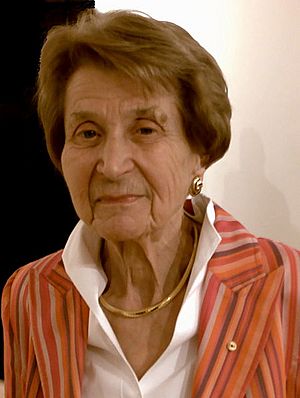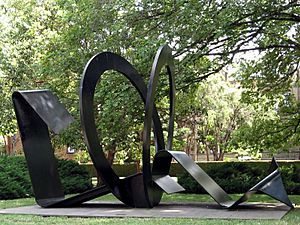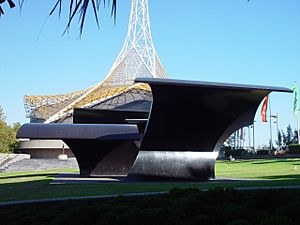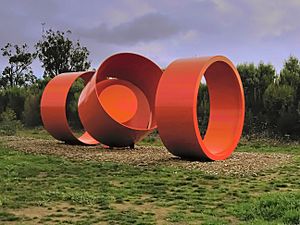Inge King facts for kids
Quick facts for kids
Inge King
|
|
|---|---|

Inge King (2008)
|
|
| Born |
Ingeborg Viktoria Neufeld
26 November 1915 |
| Died | 23 April 2016 (aged 100) |
| Nationality | German Australian |
| Education |
|
| Known for | Sculpture |
|
Notable work
|
Forward Surge (1972–74), Melbourne Arts Centre. |
| Movement | Centre 5 |
| Awards |
|
Inge King (born Ingeborg Viktoria Neufeld; 26 November 1915 – 23 April 2016) was a famous sculptor. She was born in Germany but became an Australian citizen. Inge King created many large sculptures that you can see in public places. Her art is also kept in museums and private collections. One of her most famous works is Forward Surge (1974), which is at the Melbourne Arts Centre. She was honored as a Member of the Order of Australia in 1984 for her amazing art.
Contents
Inge King's Early Life
Growing Up in Berlin
Inge King was born in Berlin, Germany, on November 26, 1915. She was the youngest of four girls in a wealthy Jewish family. Her childhood was quite normal for a girl from her background. However, after World War I, life in Germany became very hard. The time known as the Weimar Republic (1918–1933) was exciting for art and culture, but it was not stable. Things got even tougher with hyper-inflation (when money loses its value very quickly) in the early 1920s and the Great Depression in 1929.
By the time Inge's father died in 1930, when she was 14, her family had lost most of their money. Her older sisters helped her stay in school until she finished in 1932. This gave her a good education. She wanted to go to university, maybe to study medicine, but they could not afford it.
When Inge was 17, Adolf Hitler came to power in Germany on January 30, 1933. Two of her older sisters decided to move away: one went to Palestine and the other to the United States. By 1934, when she was 18, Inge was mostly on her own. She lived with other young people in a small Zionist commune. She worked there in exchange for a place to stay and food. She later said this experience taught her "independence" and how "to survive without money."
Inge started thinking about becoming an artist, even though it was her second choice. Art was something she could do with little money, as long as she could support herself. She liked both medieval sculpture and a German art style called Expressionist sculpture. She especially admired the wood-carver Ernst Barlach. The Nazis called this kind of art "Degenerate art" and tried to stop it. Inge also met the artist Käthe Kollwitz, whose work she admired. Kollwitz told Inge, "Don’t do it if you can help it. It is so difficult." But Inge went ahead anyway. She later said, "I haven’t regretted it. I agree with her, it’s difficult."
Inge found a teacher named Hermann Nonnenmacher, who taught her how to carve wood and model clay. She worked with him until she was accepted into the Berlin Academy of Fine Arts in 1937, when she was 21. She was one of only three non-Aryan (not of German descent) students there, all women. She had to leave about a year later, just before Kristallnacht (a terrible night of violence against Jewish people in November 1938). While at the Academy, she earned money by carving decorations for buildings.
Inge finally left Germany in 1939 with help from German friends. One friend helped her get a visa for England. Another friend warned her to leave quickly because he had received orders to join the army. She spent about a year working as a housekeeper for families in southern England. She found England much more old-fashioned than Berlin, which was a big surprise.
London and Glasgow Art Schools
Inge was accepted into the Royal Academy in London in 1940. She studied there for two terms before it closed because of German bombing raids. She also took evening classes in drawing at the London Central School of Arts and Crafts. When that school moved, she applied to the College of Art in Edinburgh. They accepted her, but Inge, as a foreign national, could not live in Edinburgh because it was a restricted area. So, they suggested she apply to the Glasgow School of Art.
Glasgow was a very diverse city. It had a large Jewish community and many migrants and refugees came there during the war. This made the city very lively and culturally rich.
The head of sculpture at the Glasgow School of Art was Benno Schotz. He was born in Estonia and came from a Jewish family. He moved to Glasgow and studied sculpture at night while working for a shipbuilding company. Because he was foreign-born, Schotz did not have to join the war effort. This meant the sculpture department at the School of Art stayed open throughout the war. He was an excellent teacher. He had a great connection with his students and encouraged them to explore their art. He also helped refugees and spoke out about their suffering.
Inge King started at the Glasgow School of Art in 1941 and stayed for three years. She said, "I was very happy in Glasgow. It was actually the only time I could just work the way I wanted to and I worked very hard." She felt comfortable with Schotz because they shared a European background.
Other students at Glasgow were impressed by Inge and the other refugee students. They brought a wider view of the world to the school. One student remembered, "We were an astonishing mixture of cultures and it did us the world of good."
The art made by the refugee students was different from the other students' work. It was "harsh and emotional art fueled by bitterness and anger." They talked a lot about artists like Käthe Kollwitz and discussed politics and art in Europe. Pablo Picasso's Guernica (1937) and other war-inspired art were often discussed. The Glasgow choirs sang Scottish folk songs and Afro-American spirituals, which was new and exciting for refugees like Inge.
In late 1942, Schotz organized an important exhibition of European Jewish art in Glasgow. Many of these artworks had been secretly brought out of Europe. The exhibition included works by famous artists like Camille Pissarro and Ernst Barlach. The Glasgow Art Gallery bought a bronze sculpture by Ossip Zadkine called Music Group. The Glasgow Herald newspaper called it the "outstanding item" and the first truly "modern" sculpture in the city's collection. Inge King's later sculpture, Musicians: Homage to Zadkine (1947), was inspired by this work.
Another important sculpture by Inge from this time was Warsaw. It was a small sculpture inspired by the terrible events happening in Europe. After finishing it, Inge knew she would never make another work like it.
Inge finished her formal studies in 1944. The next few years were difficult. She taught in nursery schools, which she liked but found tiring. She did not create any more of her own art until she moved back to London.
Abbey Art Centre and New York
In early 1947, Inge moved to the Abbey Art Centre. This was an artists' community near London. Many Australian artists lived there, including Robert Klippel and Grahame King, whom Inge later married.
At first, Inge's sculptures at the Abbey were of figures, but not realistic ones. During this time, she decided to move away from making art that looked exactly like real things. She said, "I could not see how I could do any more with the figure, so I decided to move into what I call non-representational work." She had two exhibitions in London and then spent six months in Paris, which she enjoyed. In September 1949, she went to New York.
New York was an amazing experience for Inge. She met many artists, including sculptors Herbert Ferber and painters Mark Rothko and Barnett Newman. She saw her first Jackson Pollock show. She found the American painters very inspiring because of their energy. New York was also "sparkling, it was clean, it was very safe still" after war-torn Europe. She met the famous architect Walter Gropius at Harvard, who was interested in her work. He offered to help her get a scholarship to the Institute of Design in Chicago.
Back in London, Inge and Grahame King decided to get married. Inge could have moved to America as a German refugee, but Grahame, being Australian, could not get a residency permit there. Inge did not want to stay in Europe. After visiting New York, she thought Australia would be like the USA – "a bright new world where she could work in a lively and adventurous atmosphere and rear a family." The Kings left London for Melbourne in early 1951.
Settling in Melbourne
When Inge arrived, Melbourne was not like New York. She found it "almost Victorian" and her first impression of Australia was: "Rather flat, like a can of flat beer." But she decided not to look back. She said, "I had emigrated once, and the first emigration is the hardest to adjust to." She couldn't make sculptures for several years. She knew she could not go back to Germany.
The Kings bought a piece of land on a bare hillside in Warrandyte. This was a small town about 25 kilometers north-east of Melbourne. In the early 1950s, it was a rural area with few services like roads, water, or electricity. The Kings asked the architect Robin Boyd to design a house for them. Boyd designed a simple, one-room house that could be made bigger over time. They did much of the building work themselves. They moved into the house at Christmas in 1952. They had no electricity for six months and no hot water for three years. They also didn't have a car for a few years. During this time, their two daughters, Joanna and Angela, were born. Inge called their life then "suburban pioneering."
Today, trees have grown on the hillside. The house is full of books and art, including small sculptures, paintings, and prints. Inge said, "Robin Boyd used to come up here and say 'This house should look awful, but it doesn't.'"
Inge had to get used to her new country. The Australian bush at Warrandyte looked strange to her at first. But she said, "Ten years later... I started to adjust to this continent - and then it took another ten years to find my own style." She also noted, "Had I gone on living in Europe, my work would have been very different."
Inge King's Art in Australia
Inge King was a leader in developing modern, non-representational sculpture in Australia. She helped start the Centre 5 group of sculptors in Melbourne in 1961. This group wanted to help more people learn about modern sculpture in Australia. Members included Julius Kane, Lenton Parr, Inge King, and Norma Redpath.
Many of Inge King's large sculptures are in public places and on university campuses. She had more than 26 solo exhibitions and was part of over 60 group exhibitions in Australia, New Zealand, London, and New York. The National Gallery of Victoria held a special exhibition of her work in 1992. She also had a joint exhibition with her husband, Grahame King, in 2004. Another exhibition featuring both their works was held in 2014.
Awards and Recognition
- 1984: She became a Member of the Order of Australia for her contributions to visual arts, especially sculpture.
- 2009: She received the Australian Arts Council Visual Arts Emeritus Award. This award recognized her important role in making modern sculpture more popular in Australia.
- 2010: A documentary film called A Thousand Different Angles about Inge King and her sculptures was shown on ABC1.
- 2015: She received The Dame Elisabeth Lifetime Achievement Award For Australian Sculpture.
Major Sculptures

Sun Ribbon
|
|
| Artist | Inge King |
|---|---|
| Year | 1980–82 |
| Medium | Sculpture |
| Subject | Painted steel |
| 37° 47′ 49.51″ S, 144° 57′ 43.4″ E | |
| Owner | University of Melbourne |

Forward Surge
|
|
| Artist | Inge King |
|---|---|
| Year | 1972 |
| Type | Sculpture |
| Medium | Painted steel |
| Location | Melbourne Arts Centre, St Kilda Road. |
Royal Australian Air Force Memorial
The Royal Australian Air Force Memorial is in Canberra. It was Inge King's first big public project, which she won in a competition. The memorial needed to show the hopes and achievements of the Royal Australian Air Force. Its motto is: Per Ardua ad Astra (meaning "through adversity to the stars"). The sculpture was put in place in 1973. It has three stainless steel panels that look like aircraft wings. The tallest one is almost 8 meters high. In the middle, there is a bronze structure. A plaque explains that the "three upsurging wing shapes... represent endurance, strength and courage, while the bronze flight image embodies man's struggle to conquer the elements." [1] You can see more images of it here: see images.
Sun Ribbon
This sculpture was put up in 1980 on a lawn at the University of Melbourne. It is made from 19mm thick steel. It has two upright steel circles, each 360 cm across, and three folded metal shapes. The whole sculpture is 6 meters long. It gives students a unique place to rest and is a main feature of a busy outdoor area at the university. You can see more images of Sun Ribbon here: see more images.
Forward Surge
Inge King's most famous sculpture is the huge Forward Surge at the Melbourne Arts Centre. The Victorian Arts Centre asked her to create this sculpture in 1974. It was finished in 1976 and put in its current spot in 1981. It is made from 50mm thick steel and is 5.2 meters high, 15.1 meters wide, and 13.7 meters deep. You can see more images of Forward Surge here: see more images.
Shearwater
This sculpture was made for Esso Australia and placed outside their building in Melbourne in 1995. It is built from colored steel. It is 780 cm high, 670 cm wide, and 350 cm deep. You can see images of Shearwater here: See images.

Rings of Saturn
|
|
| Artist | Inge King |
|---|---|
| Year | 2006 |
| Medium | Sculpture |
| Subject | Stainless steel |
| Location | Heidelberg, Victoria |
| -37° 45.519', 145° 4.974' | |
| Owner | Heide Museum of Modern Art |
Red Rings
This sculpture was created in 2008 for the EastLink collection. It is located in Melbourne, where the EastLink Trail meets the Dandenong Creek Trail. It is made of three red steel rings, each 2.5 meters wide. People can walk through the sculpture. You can see more images of Red Rings here: see more images.
Rings of Saturn
Rings of Saturn is located in the Sir Rupert Hamer Garden at the Heide Museum of Modern Art in Bulleen, a suburb of Melbourne. You can see more images of Rings of Saturn here: see more images.
Other Works
- Flower Dancer (1948), National Gallery of Victoria, Melbourne [2]
- Oracle (1966)
- Encounter (1968), La Trobe University, Melbourne-Bundoora
- Fred Schonell Memorial Fountain (1971), University of Queensland, Brisbane
- Black Sun (1975), National Gallery of Victoria, Melbourne [3]
- Dialogue of Circles (1976), La Trobe University Sculpture Park, Melbourne-Bundoora
- Temple Gate (1976/1977), Sculpture park in the National Gallery of Australia, Canberra
- Lunar Image (1980), Museum and Art Gallery of the Northern Territory (MAGNT), Darwin, Northern Territory
- Jabaroo (1984/1985), McClelland Gallery and Sculpture Park, Langwarrin, Victoria
- Silent Gong (1989)
- Island Sculpture (1991), McClelland Gallery and Sculpture Park, Langwarrin, Victoria
- Guardian Angel (1995), Deakin Museum of Art, Deakin University, Melbourne
- Nayads (1997), Monash Gallery of Art (on loan from National Gallery of Victoria), Melbourne
- Moonbird (1999 commissioned by the Australia Fund), Residence of the Prime-minister, The Lodge, Canberra
- The Sentinel (2000), Eastern Freeway in Melbourne
- Wandering Angel (2000), The National Gallery of Australia, Canberra
- Rings of Jupiter (3) (2006), National Gallery of Victoria, Melbourne [4]
- Red Rings (2008), Eastlink Motorway in Melbourne [5]
See also
 In Spanish: Inge King para niños
In Spanish: Inge King para niños
- List of centenarians (artists)
- List of German women artists


